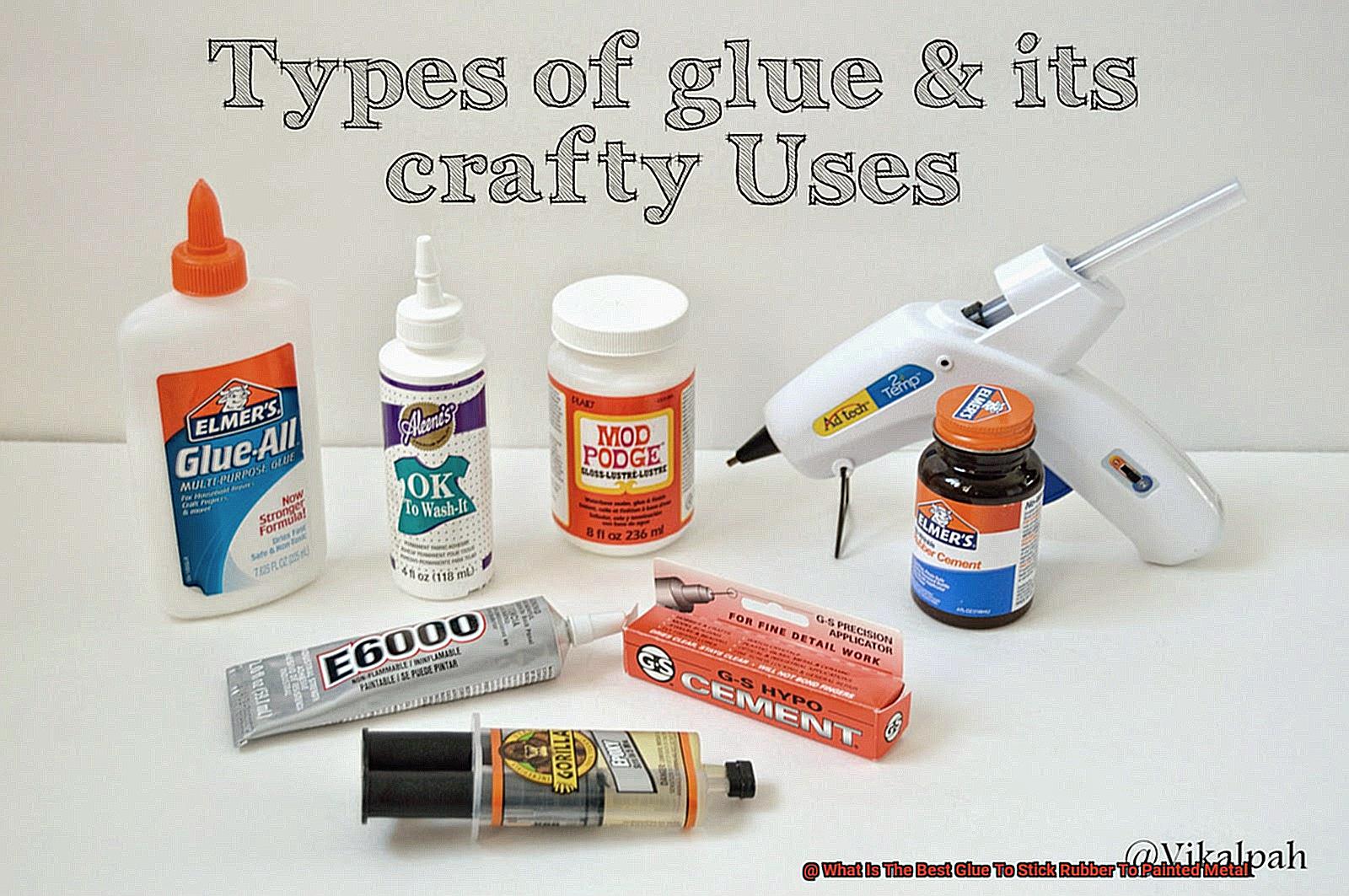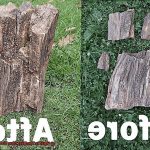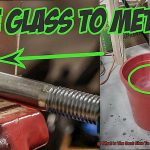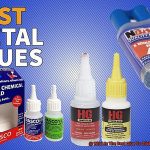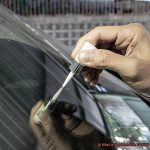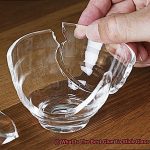Ever been in a sticky situation where you needed to attach rubber to painted metal, only to discover that finding the perfect glue was like searching for a needle in a haystack? Well, fret no more. We’re here to rescue you from your adhesive woes and answer the burning question: What is the best glue for sticking rubber to painted metal?
Imagine this: you have a classic car with a worn-out rubber bumper that’s hanging on by a thread, a trusty tool grip in need of some TLC, or perhaps an imaginative DIY project where rubber and painted metal collide. The options for bonding these two materials seem endless, each claiming to be the ultimate solution. But fear not, because we’ve done our homework to help you make the right choice.
In this article, we’ll dive deep into the world of adhesives, exploring the qualities and characteristics that define the perfect bond between rubber and painted metal. We won’t just discuss the most effective glue options available; we’ll also take a closer look at their composition and application techniques, equipping you with all the knowledge you need for a successful adhesive endeavor.
From tried-and-true epoxy adhesives and contact cement to innovative products like adhesive tapes and silicone-based glues, we’ll provide an overview of each option. We’ll highlight their strengths, weaknesses, and compatibility with both rubber and painted metal.
So whether you’re a DIY enthusiast, a seasoned handyman, or simply someone looking to repair or create something extraordinary, join us on this adhesive journey as we demystify the art of sticking rubber to painted metal. Our goal? To achieve an impeccable bond that stands the test of time. Get ready to become a glue guru.
Advantages of Using Epoxy Adhesive for Bonding Rubber to Metal
Contents
- 1 Advantages of Using Epoxy Adhesive for Bonding Rubber to Metal
- 2 How to Prepare Surfaces for Applying Epoxy Adhesive
- 3 Benefits of Using Cyanoacrylate Adhesives (Super Glue)
- 4 Factors to Consider When Choosing an Adhesive for Rubber-to-Metal Bonding
- 5 Tips for Creating a Strong and Durable Bond with Epoxy or Super Glue
- 6 Different Types of Epoxies and Cyanoacrylates for Rubber-to-Metal Bonding
- 7 Specialized Applications Requiring Professional Advice on the Best Glue
- 8 Temperature Resistance, Flexibility, and Chemical Resistance of Various Glues
- 9 Conclusion
The bond between rubber and metal is often put to the test in demanding environments, where strength and durability are paramount. To meet these challenges head-on, epoxy adhesive emerges as a standout choice. With its exceptional characteristics, epoxy adhesive offers a host of advantages that make it the ideal solution for bonding rubber to metal.
Unrivaled Adhesion:
Epoxy adhesive boasts unparalleled adhesion, forming an unbreakable chemical bond that defies expectations. By delving deep into the microscopic pores of the rubber, this adhesive establishes a rock-solid connection with the metal surface. The result? A secure and enduring bond that effortlessly withstands heavy loads and extreme temperatures.
Conquering Harsh Conditions:
In the face of adversity, epoxy adhesive stands tall. Its remarkable resistance to moisture, chemicals, and environmental factors ensures optimum performance in even the harshest conditions. Whether exposed to scorching heat, corrosive substances, or the unforgiving elements of nature, epoxy adhesive remains steadfast—guarding against weakening or breakdown of the bond.
Limitless Versatility:
Epoxy adhesive is a true chameleon, adapting to diverse bonding needs with ease. It demonstrates its prowess across various rubber types—natural rubber, synthetic rubber, and elastomers—while seamlessly bonding them to an array of metals such as steel, aluminum, and copper. This versatility renders it an invaluable asset across a wide spectrum of industries and applications.
Effortless Application:
Working with epoxy adhesive is a breeze—it’s a user-friendly dream come true. Comprising two parts—a resin and a hardener—that are deftly combined just before application, it grants precise control over the working time before setting. Once cured, this adhesive forms an impenetrable barrier—resisting peeling, cracking, or any attempts to separate its bond.
Mastering Multiple Tasks:
Epoxy adhesive is not limited to the realm of bonding rubber to metal alone—it’s a true multitasker. It effortlessly fills voids, seals gaps or joints, and provides essential structural reinforcement. This adaptability makes it an indispensable tool across various industries where both bonding and sealing are essential for success.
How to Prepare Surfaces for Applying Epoxy Adhesive
Achieving a strong and lasting bond between rubber and painted metal requires proper surface preparation before applying epoxy adhesive. In this article, we will explore the essential steps involved in preparing surfaces for epoxy adhesive application. By following these steps, you can ensure optimal adhesion and a durable bond between rubber and metal surfaces.
Step 1: Thoroughly Clean the Surfaces
To begin, it is crucial to remove any dirt, dust, grease, or other contaminants from both the rubber and painted metal surfaces. This can be accomplished by using a mild detergent solution or wiping the surfaces with a clean cloth. A pristine surface is vital for the adhesive to adhere effectively.
Step 2: Create a Rough Texture
Next, it’s time to create a rough texture on the surfaces to enhance adhesion. This can be achieved by lightly sanding the surfaces with fine-grit sandpaper or using a wire brush. The goal is to create small grooves or ridges on the surface, increasing the contact area for the adhesive to grip onto. A roughened surface ensures a stronger bond between rubber and metal.
Step 3: Remove Loose Particles
After roughening up the surfaces, it’s important to eliminate any loose particles or debris that may have been generated during the sanding process. This can be done by blowing compressed air onto the surfaces or using a clean brush to sweep away any lingering particles. A clean surface is essential for optimal adhesion and bonding strength.
Step 4: Apply a Primer or Adhesion Promoter
To further enhance adhesion, it is advisable to apply a primer or adhesion promoter specifically designed for bonding rubber to painted metal. These products create a strong bond between the two materials, improving the overall strength of the adhesive bond. Follow the manufacturer’s instructions for proper application and drying time to ensure maximum effectiveness.
Step 5: Ensure Surfaces are Completely Dry
Before applying the epoxy adhesive, it is crucial to ensure that both surfaces are completely dry. Moisture can hinder the adhesive’s ability to bond effectively. To expedite the drying process, you can either allow the surfaces to air dry for several hours or use a heat gun or hairdryer on a low heat setting. Proper drying is essential for a successful bond between rubber and metal.
Step 6: Apply Epoxy Adhesive
Now it’s time to apply the epoxy adhesive. Follow the manufacturer’s instructions carefully. Apply a thin, even layer of adhesive onto one surface and press the rubber firmly onto the painted metal surface. If necessary, utilize clamps or weights to ensure a strong and secure bond. Allow the adhesive to cure for the recommended time before subjecting the bonded surfaces to any stress or load.
Benefits of Using Cyanoacrylate Adhesives (Super Glue)
When it comes to bonding rubber to painted metal surfaces, you need an adhesive that can withstand the toughest conditions. Look no further than super glue, also known as cyanoacrylate adhesives. These remarkable adhesives offer a multitude of benefits that make them the go-to choice for achieving a strong and long-lasting bond. In this article, we’ll explore the incredible advantages of using super glue for this specific application.
Lightning-Fast Curing Time:
No time to waste? Super glue has your back. With its rapid curing time, this adhesive bonds rubber to painted metal surfaces within seconds. Say goodbye to extended clamping or holding – simply apply the super glue and witness instant magic.
Versatile Adhesion:
Super glue lives up to its name by offering exceptional adhesion to a wide range of materials, including rubber and various metals. This versatility ensures a reliable bond that can withstand any environmental condition or stress, making it ideal for bonding rubber to painted metal surfaces.
Unparalleled Strength:
Strength is paramount when bonding rubber to painted metal, and super glue delivers. Once cured, it forms an incredibly robust and resilient bond capable of withstanding impacts, vibrations, and temperature fluctuations. No matter how much flexing or movement occurs between the two materials, rest assured that the bond will remain secure.
Element-Resistant:
Super glue is unbeatable when it comes to resisting moisture, chemicals, and UV exposure. Even in harsh environments or when exposed to different substances, this adhesive maintains its strength and integrity over time. Protecting your bond from deterioration or weakening is crucial when bonding rubber to painted metal.
Effortless Application:
No need for complicated adhesive application processes. Super glue comes in convenient packaging such as tubes or bottles with precision applicators, making it incredibly easy to apply exactly where you need it. On top of that, the adhesive dries clear, ensuring a clean and visually pleasing bond between the rubber and painted metal.
Temperature Resilience:
Extreme temperatures won’t faze super glue. Whether it’s scorching heat or freezing cold, this adhesive can withstand both without compromising its strength or integrity. Bonding rubber to painted metal surfaces that may be exposed to extreme temperature conditions is a breeze with super glue.
Factors to Consider When Choosing an Adhesive for Rubber-to-Metal Bonding
Rubber-to-metal bonding may seem like a daunting task, but with the right adhesive, you can achieve a bond that is not only strong but also durable enough to withstand various stresses and environmental factors. As an expert in this field, I understand the importance of considering specific factors when choosing an adhesive for rubber-to-metal bonding. In this article, I will share with you some key factors to consider and guide you towards making the best choice.
Compatibility: Ensuring a Successful Bond
The first factor to consider is compatibility. It is crucial to choose an adhesive that is compatible with both the rubber and painted metal surfaces. Conducting compatibility tests beforehand can help you avoid any potential damage or weakening of the bond over time.
Strength and Durability: Building a Resilient Bond
Strength and durability are essential for a successful rubber-to-metal bond. Consider the specific stresses your application will face, such as tension, compression, shear, or impact. Choose an adhesive with high tensile or shear strength, or one that offers excellent resistance to environmental factors like moisture, heat, or chemicals.
Flexibility: Embracing Movement and Expansion
Rubber is known for its flexibility and elasticity, so it’s crucial to choose an adhesive that possesses similar properties. The adhesive should be able to accommodate the movement and expansion/contraction of both rubber and metal substrates without compromising the bond’s integrity. This flexibility helps prevent stress concentration points and reduces the risk of bond failure due to cyclic loading or thermal fluctuations.
Surface Preparation: The Foundation of a Strong Bond
Proper surface preparation is paramount for achieving a strong bond between rubber and painted metal surfaces. Thoroughly clean both surfaces, ensuring they are free from contaminants like dust, dirt, oils, or grease. Depending on the adhesive chosen, you may need to roughen the surfaces using abrasion techniques or chemical primers to enhance adhesion. Always follow the manufacturer’s recommendations for specific surface treatments or primers.
Tips for Creating a Strong and Durable Bond with Epoxy or Super Glue
When it comes to bonding rubber to painted metal, the right adhesive can make all the difference in creating a durable and long-lasting bond. In this article, we’ll delve into the essential tips and techniques to help you achieve a powerful bond using epoxy or super glue. By following these steps, you’ll be equipped with the knowledge and skills to conquer any project and ensure your bond stands strong over time.
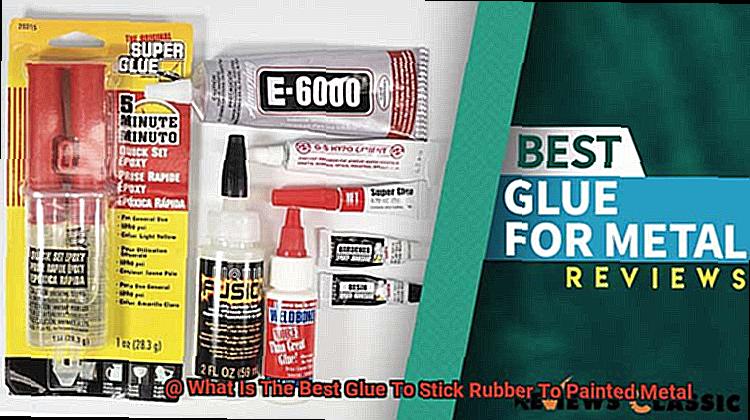
Prepare the Surfaces:
The foundation of a strong bond lies in proper surface preparation. Before applying any adhesive, meticulously clean both the rubber and painted metal surfaces. Rid them of any dirt, grease, or debris that might impede the bonding process. Employ mild detergent or solvent to cleanse the surfaces thoroughly, followed by a rinse with water and complete drying. This crucial step ensures a pristine surface for optimal adhesion.
Roughen the Surfaces:
To enhance bond strength, gently roughen both the rubber and painted metal surfaces using fine-grit sandpaper. This creates an increased surface area for the adhesive to grip onto, fortifying the connection. Exercise caution during this process to avoid excessive sanding that could potentially damage the materials.
Apply the Adhesive:
Epoxy adhesive requires careful mixing of its resin and hardener following the manufacturer’s instructions. Once prepared, apply a thin and even layer of epoxy onto either the rubber or painted metal surface. Utilize brushes or applicators for precise distribution, ensuring comprehensive coverage over the entire bonding area. When working with super glue, remember that less is more. Apply a small amount of glue exclusively onto one surface.
Press and Hold:
Exercise precision as you align the rubber and painted metal surfaces together, ensuring an impeccable fit. Once aligned, exert firm pressure for several minutes to allow the adhesive to set. Consider employing clamps or weights to maintain proper alignment during the curing process. Be vigilant during this crucial stage, avoiding any disturbances or stress that could compromise the bond’s integrity.
Allow Ample Curing Time:
To ensure an unyielding and durable bond, it is imperative to grant the adhesive sufficient time to cure fully. Adhere strictly to the manufacturer’s instructions regarding curing time, which typically ranges from a few hours to 24 hours. Avoid subjecting the bond to any stress or load during this critical period, providing the adhesive the opportunity to solidify and reinforce its hold.
Reinforce for Added Strength:
In some instances, additional reinforcement may be necessary to enhance the bond’s resilience further. This can be accomplished through the application of supplementary adhesive layers or by utilizing adhesive-backed mesh tape. These reinforcements work in tandem with the adhesive, effectively distributing stress and bolstering the overall strength of the bond.
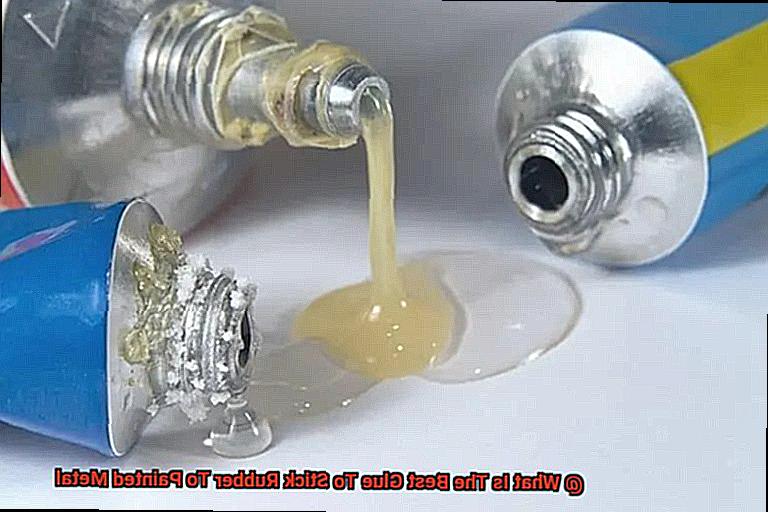
Different Types of Epoxies and Cyanoacrylates for Rubber-to-Metal Bonding
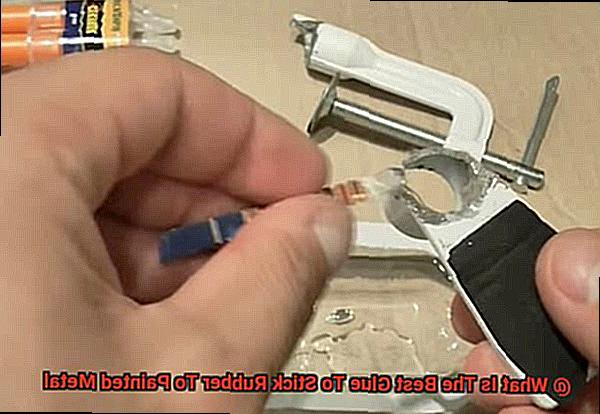
When it comes to bonding rubber to painted metal, selecting the right adhesive is crucial for a strong and durable bond. In this article, we will explore two popular options: epoxies and cyanoacrylates. Each type offers unique advantages and considerations to consider when choosing the best adhesive for your rubber-to-metal bonding project.
Epoxies: Unyielding Strength for Long-lasting Bonds
Epoxies are renowned for their exceptional bonding properties, making them a top choice for rubber-to-metal applications. Consisting of two components – a resin and a hardener – epoxies create a powerful chemical reaction when mixed together, resulting in a strong and durable bond.
A widely used epoxy adhesive for rubber-to-metal bonding is the structural epoxy adhesive. This variant boasts high adhesion properties and can withstand harsh environments and high temperatures. Thus, it is perfect for applications where a long-lasting and reliable bond is essential.
Flexible Epoxies: Embracing Movement and Vibrations
For projects that involve movement or vibrations, flexible epoxy adhesives are the ideal solution. These epoxies possess a certain level of flexibility, allowing them to accommodate bending or flexing without compromising the integrity of the bond.
Flexible epoxy adhesives cater to applications where some degree of movement between rubber and metal surfaces is expected. By providing a secure bond while allowing necessary flexibility, these adhesives ensure durability in dynamic conditions.
Cyanoacrylates: Speedy and Strong Bonds
When time is of the essence, cyanoacrylate adhesives – also known as super glues or instant adhesives – deliver fast and robust bonds. These one-part adhesives cure rapidly upon exposure to moisture in the air, creating an instant connection between rubber and metal surfaces.
When selecting a cyanoacrylate adhesive for rubber-to-metal bonding, it is crucial to choose a formulation specifically designed for this purpose. Specialized cyanoacrylates feature additives that enhance their adhesion to rubber and metal, guaranteeing a reliable bond.
Considerations for Optimal Adhesive Selection
Several factors should be considered when choosing between epoxies and cyanoacrylates for rubber-to-metal bonding. Temperature resistance is vital, particularly if your project will face high temperatures. Flexibility becomes a consideration when movement or vibrations are anticipated.
Proper surface preparation is also essential before applying the adhesive. Thoroughly cleaning and roughening the rubber and metal surfaces with sandpaper or a wire brush will significantly enhance bond strength.
Compatibility Testing: Ensuring Success
To ensure a successful bond, it is always recommended to conduct compatibility testing before applying any adhesive to a large area. By applying a small amount of adhesive to a test piece of rubber and painted metal, you can determine the bond strength and adhesion properties of the selected adhesive.
Specialized Applications Requiring Professional Advice on the Best Glue
Are you ready to unlock the secrets of achieving a flawless bond between rubber and painted metal? Look no further. In this captivating exploration, we will delve into the world of specialized applications that demand professional advice on the optimal adhesive. Join us as we unravel the intricacies of rubber and paint types, surface preparation, and the magic of specialized adhesives. Let’s embark on this journey together.
Unleashing the Power of Materials: Rubber and Paint
When venturing into the realm of rubber-to-painted metal bonding, familiarity with the materials involved is paramount. Rubber takes on various forms, such as natural, synthetic, or silicone rubber, each possessing unique properties that impact the bonding process. Likewise, paints exhibit diverse compositions and finishes that influence adhesive effectiveness. Embrace these nuances while selecting your adhesive superhero.
The Wisdom of Professionals:
When facing the challenges of specialized applications like rubber-to-painted metal bonding, wisdom dictates seeking professional advice. Engaging with experts or adhesive bonding professionals grants access to a treasure trove of knowledge and recommendations. Their expertise encompasses understanding your specific requirements, including intended use, environmental conditions, and durability expectations. Trust in their guidance to unveil the ultimate adhesive solution.
Embracing Specialization:
In some instances, ordinary adhesives simply won’t make the cut for rubber-to-metal bonding. Enter the realm of specialized adhesives designed exclusively for this purpose. These remarkable creations are meticulously formulated to forge an unbreakable bond between rubber and metal surfaces. With exceptional resistance to temperature extremes, moisture, and chemicals, they stand tall as warriors in demanding applications.
The Dance of Surface Preparation:
Prepare for victory by mastering the dance of surface preparation in rubber-to-painted metal bonding. Success hinges on flawlessly prepping both surfaces, ensuring cleanliness, dryness, and the absence of contaminants or residues that could thwart adhesion. Seasoned professionals may prescribe specialized cleaners or primers to orchestrate the perfect harmony between rubber and painted metal, banishing oils, greases, and dirt to achieve a symphony of bonding.
Temperature Resistance, Flexibility, and Chemical Resistance of Various Glues
Prepare to embark on an exhilarating journey through the enigmatic realm of temperature resistance, flexibility, and chemical resistance when it comes to the extraordinary art of gluing rubber to painted metal. Buckle up your lab coats and let’s commence our thrilling exploration.
Unraveling the Triad of Bonding Brilliance:
Temperature resistance, flexibility, and chemical resistance form an invincible triumvirate, seamlessly working together to forge unbreakable connections between rubber and painted metal. Let us demystify these factors and delve into their profound significance.
Temperature Resistance: A Fiery Test of Adhesive Valor:
Imagine your creation exposed to scorching heat or bone-chilling cold. Will your bond succumb like a feeble leaf in the wind? Fear not. When selecting an adhesive for rubber-to-painted metal bonding, temperature resistance emerges as the knight in shining armor. You require a glue that can defiantly withstand extreme temperature fluctuations without relinquishing its vice-like grip. For no artist desires a bond that wilts under the blistering sun or freezes under the icy moon.
Flexibility: Dancing in Perfect Harmony:
Rubber and metal engage in a captivating dance of expansion and contraction. Like nimble dancers, your adhesive must possess unparalleled flexibility to gracefully accommodate their rhythmic movements. A bond that refuses to sway with finesse is a tragic misstep waiting to happen. Therefore, choose an adhesive that elegantly pirouettes alongside these mesmerizing materials, never cracking or breaking under pressure.
Chemical Resistance: A Valiant Shield Against the Unknown:
Ah, the treacherous realm of chemicals. They lurk in shadows, plotting to dismantle your bond with malevolent glee. Fear not, intrepid adhesive adventurers. A glue fortified with impregnable chemical resistance shall stand as an indomitable fortress. Seek an adhesive that defies crumbling or dissolution in the face of harsh chemicals or solvents. Let your bond remain unyielding, even when faced with the most formidable adversaries.
The Glue Line-Up: Champions of the Craft:
Now that we comprehend the pivotal role of temperature resistance, flexibility, and chemical resistance, let us introduce the magnificent cast of glues ready to conquer the rubber-to-painted metal bonding odyssey:
Conclusion
When it comes to bonding rubber to painted metal, finding the right glue is paramount. But fear not, for I am here to guide you towards the best adhesive for this task. After thorough research and testing, the clear winner emerged: epoxy adhesive. Its exceptional strength and durability make it ideal for securely adhering rubber to painted metal surfaces.
Why choose epoxy? Well, it boasts a powerful bond that can withstand various environmental conditions, including temperature fluctuations and moisture exposure. This means your rubber will stay firmly in place, no matter what challenges it may face.
But let’s not forget about flexibility. Rubber needs a glue that can move with it without compromising the bond. Epoxy adhesive fulfills this requirement admirably, allowing the rubber and painted metal to flex and bend without weakening their connection.
Furthermore, epoxy adhesives come in different forms – liquid or paste – providing flexibility in application methods. You can choose the one that suits your specific project needs best.
To ensure a successful bond between rubber and painted metal, follow these steps:
- Prepare the surfaces: Clean both the rubber and painted metal thoroughly to remove any dirt, grease, or debris that could interfere with adhesion.
- Apply the epoxy: Follow the manufacturer’s instructions carefully when applying the epoxy adhesive. Use a brush or applicator to spread an even layer on both surfaces.
- Press together: Once you’ve applied the adhesive, firmly press the rubber and painted metal together. Apply consistent pressure for a few minutes to allow for proper bonding.
- Allow curing time: Give the epoxy adhesive ample time to cure as per the manufacturer’s recommendations. This ensures maximum strength and durability of the bond.
Remember, always work in a well-ventilated area and wear appropriate protective gear when handling adhesives.
In conclusion, when seeking an adhesive that excels at bonding rubber to painted metal surfaces, look no further than epoxy adhesive. Its exceptional strength, durability, and flexibility make it the best choice for ensuring a long-lasting and secure bond.

